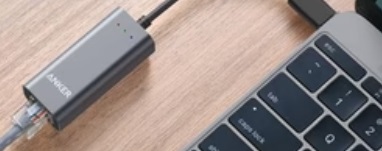USB to Ethernet adapters offer a practical solution for achieving a stable, fast internet connection on devices that lack built-in Ethernet ports. Ideal for everything from remote work to gaming, these adapters convert a USB port into an Ethernet port, giving users the benefits of a wired connection. However, with various types and features available, selecting the right USB to Ethernet adapter can be challenging. This guide will help you understand the factors to consider, ensuring you choose an adapter that best suits your needs.
Factors to Consider When Choosing the Adapter
Understanding USB Standards and Connection Speeds
When selecting a USB to Ethernet adapter, it’s essential to understand USB standards, as they determine connection speed. Most adapters use either USB 2.0 or USB 3.0/3.1 standards. USB 2.0 adapters are generally slower, supporting speeds up to 480 Mbps, which can be sufficient for basic browsing and standard definition streaming but may fall short for high-speed internet plans.
In contrast, USB 3.0 and 3.1 adapters support speeds up to 5 Gbps and 10 Gbps, respectively. These adapters are ideal for high-speed connections, handling tasks like gaming, HD streaming, and large data transfers with ease. When selecting an adapter, look for a USB version that matches your device’s port capabilities. Many laptops and computers now feature USB 3.0 or higher, so pairing them with an adapter of the same standard will provide the best possible performance and minimize any bottlenecks.
Selecting the Right Ethernet Speed Compatibility
Ethernet adapters also vary in the maximum speed they support. The two main types are Fast Ethernet and Gigabit Ethernet. Fast Ethernet supports speeds up to 100 Mbps, while Gigabit Ethernet adapters handle up to 1,000 Mbps (1 Gbps). Gigabit Ethernet adapters are recommended for users with high-speed internet plans, especially if you’re working with large files, streaming in HD, or engaging in online gaming, as they ensure you can take full advantage of your internet bandwidth.
Additionally, Gigabit Ethernet adapters are more future-proof, as internet speeds continue to increase. Some adapters even support 2.5G Ethernet for ultra-high-speed networks, which may be beneficial if you’re in an environment with advanced networking needs. Choosing an adapter that matches your internet plan’s speed ensures you’re not paying for more bandwidth than you can utilize and avoids unnecessary slowdowns.
Assessing Compatibility with Your Devices
Compatibility is crucial when choosing a usb to ethernet adapter, as different devices have different requirements. Start by checking the USB ports on your device; some may only support USB-A, while others may use the more modern USB-C. Many newer laptops and tablets are shifting to USB-C ports, known for their faster data transfer rates and versatility, so make sure your adapter aligns with your port type.
Most USB-to-Ethernet adapters are compatible with major operating systems like Windows, macOS, and Linux. However, it’s essential to confirm compatibility, especially if you’re using a less common system like Chrome OS. Some adapters may require specific drivers to function, while others are plug-and-play, requiring no additional software. Reading product descriptions and reviews can help ensure the adapter you select will work seamlessly with your device, preventing installation issues.

Considering Adapter Size and Portability
Size and portability are important considerations, particularly if you’re frequently on the move. USB to Ethernet adapters come in various shapes and sizes, with some compact models designed for maximum portability. If you’re a frequent traveler or remote worker, choosing a small, lightweight adapter will allow you to carry it easily in your bag without taking up much space.
Additionally, some USB-to-Ethernet adapters feature extra ports or come in hub designs, which can be convenient for users who need to connect multiple devices. These multifunctional adapters may include additional USB ports or HDMI connections, turning a single USB-C or USB-A port into a versatile connection hub. However, these tend to be bulkier, so consider your mobility needs and workspace setup before deciding.
Choosing Between Plug-and-Play and Driver-Required Adapters
Ease of use is another important aspect to consider. Many USB-to-Ethernet adapters are plug-and-play, meaning they don’t require any drivers to install. Plug-and-play adapters are user-friendly and ideal for people who want a hassle-free setup experience. However, some adapters, especially those with advanced capabilities or for specific operating systems, may require driver installation.
If you’re tech-savvy or don’t mind installing drivers, this won’t be a significant issue. However, if you want an adapter that works right out of the box or if you’re purchasing it for a less technically inclined user, a plug-and-play model may be preferable. Many product listings specify whether the adapter is plug-and-play or requires drivers, so checking these details before purchase can save time and effort.
Evaluating Additional Features for Enhanced Performance
Some USB-to-Ethernet adapters come with extra features designed to enhance performance and usability. For example, certain models include LED indicators that show connection status, which can help diagnose network issues quickly. Others have features like shielding and over-voltage protection, which add durability and ensure stable performance.
Adapters designed for heavy use may offer higher durability, often constructed with reinforced cables or aluminum casing to withstand frequent plugging and unplugging. Additionally, advanced features like Wake-on-LAN (WoL) can be beneficial if you need to manage or wake devices remotely. Choosing an adapter with the right blend of features can help maximize its usefulness and provide a long-lasting solution for your networking needs.
Conclusion
Selecting the right USB to Ethernet adapter can make a significant difference in your internet experience, especially if you need speed and stability for professional or entertainment purposes. By considering factors such as USB standard, Ethernet speed compatibility, device compatibility, size, and additional features, you can find an adapter that meets your specific requirements. Whether you’re a remote worker, gamer, or traveler, the right adapter provides a reliable and versatile solution, ensuring fast and stable connections across all your devices. Embrace a USB to Ethernet adapter that aligns with your needs to make the most of your internet connection, wherever you are.